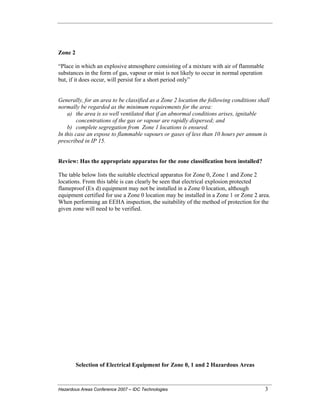Our Roar Solutions PDFs
Wiki Article
The Best Strategy To Use For Roar Solutions
Table of ContentsThe Ultimate Guide To Roar SolutionsHow Roar Solutions can Save You Time, Stress, and Money.Not known Details About Roar Solutions
In order to safeguard installations from a possible surge a method of evaluating and identifying a possibly dangerous area is called for. The function of this is to ensure the proper choice and installation of devices to ultimately protect against an explosion and to make certain security of life.
(https://dzone.com/users/5292804/roarsolutions.html)
No devices must be mounted where the surface area temperature level of the tools is above the ignition temperature level of the offered threat. Below are some usual dirt unsafe and their minimum ignition temperature. Coal Dirt 380C 225C Polythene 420C (melts) Methyl Cellulose 420C 320C Starch 460C 435C Flour 490C 340C Sugar 490C 460C Grain Dust 510C 300C Phenolic Resin 530C > 450C Aluminium 590C > 450C PVC 700C > 450C Soot 810C 570C The probability of the threat being existing in a focus high adequate to trigger an ignition will certainly vary from location to location.
In order to classify this risk an installment is separated into locations of risk relying on the amount of time the harmful exists. These locations are referred to as Areas. For gases and vapours and dirts and fibres there are 3 zones. Area 0 Zone 20 A hazardous atmosphere is very most likely to be present and might be existing for extended periods of time (> 1000 hours each year) or also continuously Area 1 Zone 21 A harmful ambience is feasible but not likely to be existing for extended periods of time (> 10 450 C [842 F] A classification of T6 means the minimal ignition temperature is > 85 C [185 F] Unsafe area electric tools perhaps developed for use in greater ambient temperatures. This would certainly suggested on the ranking plate e.g. EExe II C T3 Ta + 60C( This indicates at 60C ambient T3 will not be surpassed) T1 T1, T2, T3, T4, T5, T6 T2 T2, T3, T4, T5, T6 T3 T3, T4, T5, T6 T4 T4, T5, T6 T5 T5, T6 T6 T6 A T Class score of T1 suggests the maximum surface area temperature created by the instrument at 40 C is 450 C. Thinking the connected T Course and Temperature ranking for the tools are appropriate for the area, you can constantly utilize an instrument with an extra strict Department rating than needed for the area. There isn't a clear response to this question however. It actually does rely on the type of tools and what repair work require to be executed. Equipment with specific examination procedures that can not be carried out in the area in order to achieve/maintain third celebration ranking. Must return to the manufacturing facility if it is prior to the devices's solution. Area Repair Work By Authorised Worker: Difficult testing may not be called for however specific procedures might require to be followed in order for the equipment to preserve its 3rd party score. Authorized workers have to be utilized to do the job correctly Repair work need to be a like for like substitute. New part must be thought about as a straight substitute calling for no special testing of the equipment after the fixing is full. Each item of equipment with a harmful ranking need to be evaluated independently. These are outlined at a high level below, but also for even more detailed information, please refer straight to the standards.
Some Known Facts About Roar Solutions.
The tools register is a detailed database of tools records that consists of a minimum set of fields to identify each product's place, technological parameters, Ex lover classification, age, and ecological data. This details is vital for tracking and managing the equipment effectively within dangerous locations. In contrast, for periodic or RBI tasting inspections, the grade will be a combination of Detailed and Close inspections. The ratio of Comprehensive to Close examinations will be established by the Tools Threat, which is analyzed based on ignition threat (the likelihood of a source of ignition versus the possibility of a flammable environment )and the harmful area category( Area 0, 1, or 2). This variant will likewise influence the resourcing needs for job prep work. As soon as Great deals are defined, you can establish tasting plans based on the example size of each Whole lot, which describes the variety of random equipment items to be inspected. To establish the needed example dimension, 2 aspects require to be assessed: the dimension of the Great deal and the group of evaluation, which suggests the degree of effort that need to be applied( decreased, normal, or raised )to the inspection of the Lot. By integrating the category of examination with the Whole lot size, you can then establish the suitable rejection criteria for an example, suggesting the allowed variety of faulty things found within that sample. For even more details on this procedure, please describe the Energy Institute Guidelines. The IEC 60079 standard recommends that the optimum interval between inspections ought to not surpass 3 years. EEHA evaluations will certainly also be performed outside of RBI projects as component of set up maintenance and tools overhauls or fixings. These inspections can be attributed toward the RBI sample sizes within the influenced Whole lots. EEHA evaluations are performed to determine mistakes in electrical devices. A weighted racking up system is vital, as a solitary tool might have multiple mistakes, each with differing levels of ignition danger. If the consolidated score of both examinations is less than two times the mistake score, the Great deal is considered appropriate. If the Great deal is still thought about unacceptable, it must undertake a complete evaluation or reason, which might trigger stricter assessment procedures. Accepted Lot: The sources of any type of faults are recognized. If a common failing mode is discovered, added devices may require maintenance. Faults are identified by severity( Safety and security, Stability, Home cleaning ), making certain that urgent issues are examined and attended to immediately to reduce any influence on safety and security or procedures. The EEHA database ought to track and tape-record the lifecycle of mistakes together with the restorative activities taken. Implementing a robust Risk-Based Evaluation( RBI )strategy is vital for ensuring conformity and safety in taking care of Electric Tools in Hazardous Areas( EEHA) (hazardous area electrical course). Automated Mistake Rating and Lifecycle Monitoring: Easily handle faults and track their lifecycle to improve assessment accuracy. The intro of this assistance for risk-based assessment even more reinforces Inspectivity's placement as a best-in-class remedy for regulatory conformity, as well as for any kind of asset-centric evaluation use situation. If you are interested in discovering more, we welcome you to ask for a demo and find just how our solution can change your EEHA monitoring procedures.
Everything about Roar Solutions

In terms of eruptive risk, an unsafe location is an environment in which an explosive environment is present (or might be anticipated to be existing) in quantities that need unique preventative measures for the building and construction, installation and use equipment. Roar Training Solutions. In this write-up we explore the challenges faced in the work environment, the risk control measures, and the required proficiencies to work safely
It is a consequence of contemporary life that we manufacture, store or manage a series of gases or liquids that are deemed combustible, and a range of dusts that are deemed combustible. These materials can, in specific conditions, form eruptive environments and these can have significant and tragic effects. A lot of us are familiar with the fire triangle eliminate any kind of among the 3 aspects and the fire can not happen, however what does this mean in the context of dangerous locations? When breaking this down into its simplest terms it is basically: a mix of a certain amount of release or leakage of a certain substance or product, blending with ambient oxygen, and the existence of a resource of ignition.
click to find out more In most instances, we can do little about the degrees of oxygen airborne, however we can have considerable impact on resources of ignition, for instance electric tools. Hazardous locations are documented on the hazardous location category illustration and are identified on-site by the triangular "EX LOVER" indication. Here, amongst other crucial information, zones are divided right into three kinds depending on the danger, the likelihood and period that an explosive atmosphere will exist; Area 0 or 20 is considered the most dangerous and Area 2 or 22 is regarded the least.
Report this wiki page